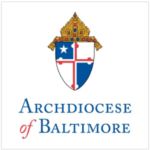Archbishop Edwin F. O’Brien, of Baltimore, will dedicate the Pope John Paul II Prayer Garden in honor of the Pope’s 1995 visit to Baltimore, on Thursday, October 23 at 10 a.m. The garden, located at the corner of Charles and Franklin Streets in Baltimore, was constructed in six months and celebrates Baltimore and Maryland’s rich religious history.
The garden was designed by the Baltimore landscape architecture firm of Mahan Rykiel Associates, Inc. and constructed by Conewago Enterprises of Hanover, PA. Its design combines the serenity of landscape—grassy areas, flowers, and trees– with the versatility of hardscape–statuary and masonry imbued with religious writings and symbols– to create a contemplative and prayerful experience that seamlessly compliments a visit to the neighboring Baltimore Basilica, America’s First Cathedral.
The garden features plants, shrubs, and trees specifically chosen for their relation to the Bible, Pope John Paul II, or the local area. For example, the colors of the fall annuals reflect those of the Papal flag: yellow and white. In the spring, the blooming annuals will be red and white– the colors of the flag of the Pope’s native Poland. Kousa dogwood trees were chosen because they tell a “visual story of the crucifixon of Jesus,” according to Mr. Steve Kelly of Mahan-Rykiel. “The bracts (flowers) are in the shape of a cross, while the ends of the bracts resemble the nail scars and the blood. The center is the crown of thorns worn by Jesus.”
The centerpiece of the garden is a seven-feet-tall, 850-pound bronze statue perched atop a polished granite base, patterned after a photograph of Pope John Paul II’s 1995 arrival at BWI Airport. The sculpture, in which the Pope is greeting two children, was created by Baltimore native and internationally-renowned sculptor, Joseph Sheppard, who cast it at his studio in Pietrasanta, Italy.
Other notable features include:
- An overhead view reveals the garden’s fish shape, reflecting the image often associated with Jesus throughout the Bible.
- An oval lawn takes the shape of the “fish’s head” and a brick pathway forms the perimeter of the entire fish shape.
- The bricks used in the garden match those used in the streetscape on Charles and Franklin Streets, while the iron fence is a modern interpretation of the one that surrounds the adjacent Basilica.
- A granite wall, forming the southern border of the garden, will be inscribed with a quote from the Pope about religious freedom and will be lit at night. The Pope’s words come from his visit to the Cathedral of Mary Our Queen in 1995.
- Stainless steel bands are also embedded in the wall and bear the symbols of the three monotheistic religions: Christianity, Islam and Judaism.
- The concrete pillars holding up the inscription wall bear the seal of the Archdiocese and the coat of arms of Pope John Paul II.
- The adjacent Franklin Street Parking Garage wall will be covered with a mural designed by ID 8, a division of RTKL of Baltimore, and awaiting final approval by the Baltimore City Board of Estimates. It will be constructed of perforated vinyl and include four quotes from the late Pope highlighting the responsibility humanity has for nature and the environment, as well as depictions of flowers and plants dedicated to Mary.
- The mural design calls for depictions of the following flowers traditionally associated with Mary: Rose, symbolizing the Virgin herself (early rosary beads were made from compressed rose petals); Lily of the Valley, also called “Our Lady’s Tears” (it was said to have grown where Mary wept); Marigold, called “Mary’s Gold” by early Christians who placed the flowers around statues of Mary, offering the blossoms in place of coins; and Lily, a symbol of the Annunciation and Mary’s purity (according to tradition, the soft whiteness of the Madonna lily became so only after she picked one–prior to that it had been yellow).
- The garden will be open during the hours of operation of the Basilica and will be maintained by the Basilica staff.
- The masonry work was done by Baltimore Masonry, the iron work by Guttierez Studios in Hampden, and the landscaping by Outside Unlimited in Hampstead.
The cost of the garden is $1.5 million. Funded by private donations, smaller replicas of the centerpiece statue were sold to raise the needed funds.

